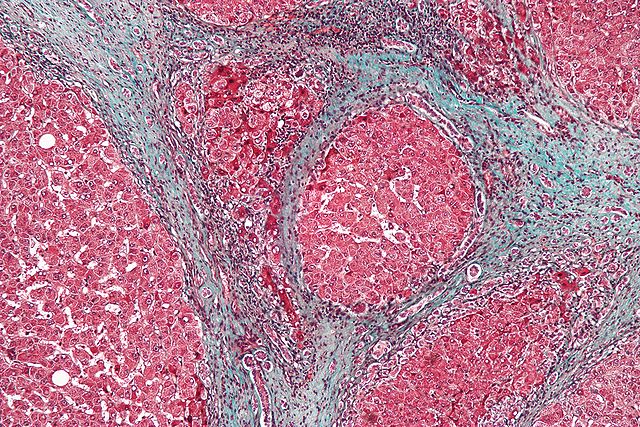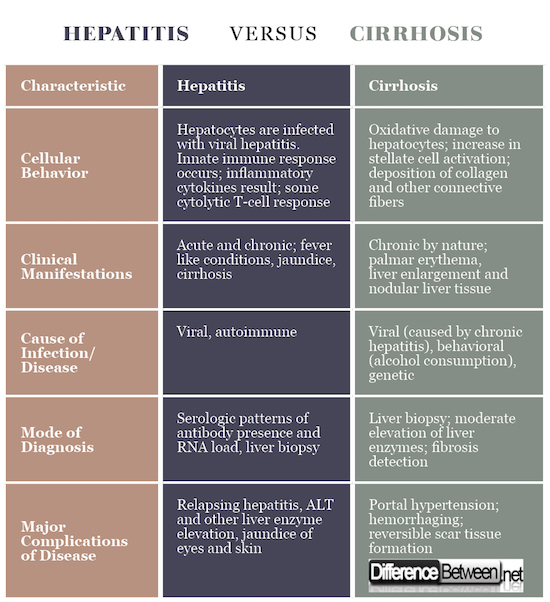Difference Between Hepatitis and Cirrhosis
Proper liver function depends on the liver to detoxify metabolites, synthesize proteins, and produce different chemicals for digestion.
Hepatitis and cirrhosis are two diseases that present different roadblocks to this normal function. Hepatitis is an infection of the liver, usually caused by a virus, that leads to acute or chronic inflammation of the liver.
Cirrhosis is the scarring of the liver whereby healthy liver tissue is not generated to replace the scarred tissue.
While both hepatitis and cirrhosis affect the liver, hepatitis has many variants, from hepatitis A through E (and even an autoimmune hepatitis), while cirrhosis may actually be caused by chronic hepatitis infection.
Of course, cirrhosis has many causes, but is limited to a particular few: alcoholic liver disease, nonalcoholic fatty liver disease, chronic hepatitis C, and chronic hepatitis A. Less common causes of cirrhosis include autoimmune hepatitis, various diseases that destroy or block the bile ducts, genetically inherited liver diseases, long term use of certain medications, and chronic heart failure with liver congestion.
Hepatitis in its various forms also has many causes including but not limited to the following generalized areas: direct sexual contact, sharing needles with an infected person, or being accidentally stuck with a needle from an infected person.
What is Hepatitis?
Hepatitis is usually a viral infection of the liver that causes chronic or acute inflammation of the liver and ultimately damage to the liver tissue. There are different types of hepatitis. Hepatitis A and E are caused by ingesting food or water that is contaminated. Hepatitis B is caused by direct contact with some bodily fluid (i.e., blood, semen) of an infected person. Hepatitis C is blood-borne and usually contracted by sharing of needles with an infected person. Hepatitis D is unique in that it only occurs in people with hepatitis B, usually through infectious blood contact.
The symptoms of these variants are similar because they affect the liver. Acute viral infection of hepatitis occurs in three phases: prodromal phase, yellowing of the skin and whites of the eyes, and the recovery phase. In the prodromal phase, non-specific flu-like symptoms occur, along with dark urine. In the recovery phase, after yellowing of skin and eyes has occurred, liver blood enzymes — like bilirubin, ALT, and AST — remain elevated.
Chronic hepatitis, or cases of hepatitis continued from more than six months, is often asymptomatic. However, fatigue, nausea, vomiting, loss of appetite and joint pain can occur. If not treated, hormonal disfunctions can occur in women. Cirrhosis is the ultimate result of continued damage.
On the cellular and molecular level, hepatitis is characterized by the following pathology:
- Morphological changes of hepatocytes – shattering of endoplasmic reticulum
- Disturbance in hepatic protein secretion
- Cell death by dehydration or rupturing
- Portal inflammation predominated by lymphocytes
- Lobular necrotic activity of hepatocytes
What is Cirrhosis?
Cirrhosis is a disease that causes proliferation and scarring of the liver by increasing the production of connective tissue in the liver, distorting the blood flow architecture and ultimately causing necrosis of the liver. It was thought that this condition was irreversible upon diagnosis, but it turns out that if the underlying cause is addressed, it can reverse the fibrosis (i.e., generation of “stiff” connective proteins) that causes cirrhosis of the liver.
Cirrhosis and hepatitis are similar in that they are both conditions of the liver. In addition, cirrhosis is seen as a result of a chronic hepatitis infection. Both are also characterized by slow death of hepatic cells after prolonged injury by their established perpetrators: inflammatory response in hepatitis and collagen deposition in cirrhosis.
Cirrhosis patients present symptoms such as abdominal pain, fever, nausea, and diarrhea. Other advanced symptoms include GI hemorrhages, edema, and ascites.
On the cellular and molecular level, cirrhosis is characterized by the following pathology:
- Oxidative damage to hepatocytes due to formation of reactive oxygen species
- Interference with microtubular formation and protein trafficking
- Production of excess collagen and extracellular matrix in the periportal and pericentral zone of the liver
- Activation of stellate cells that enhance fibrosis
- Impaired protein synthesis, secretion, and glycosylation
Difference Between Hepatitis and Cirrhosis
Cell Behavior
Hepatitis is usually characterized by cells being infected with a hepatitis virus and eliciting an immune response, while cirrhosis is characterized by activation of particular cells that increase deposition of connective tissues and nodules.
Mode of Infection
Hepatitis is usually a viral infection, but it can also be autoimmune. Cirrhosis is a behaviorally determined disease through alcohol consumption, or a genetic predisposition disease through fatty liver disease.
Clinical Presentation
Hepatitis results in jaundice and mild fever-like symptoms in the short-term, and cirrhosis in the long-term. Cirrhosis results in nodular tissue and necrotic liver tissue.
Longevity of Disease
Hepatitis can be acute (i.e., < 6 months) or chronic (i.e., > 6 months), while cirrhosis was seen as a permanent condition once diagnosed, until very recently. It is now seen as reversible.
Organ Character
Inflammation and swelling of the liver characterize hepatitis. Some cell death and immune blockage may occur. In cirrhosis, scarring of the tissue and lack of blood flow to portal areas of the liver are common.
Hepatitis vs. Cirrhosis: Comparison Table
Summary of Hepatitis versus Cirrhosis
- Hepatitis and cirrhosis are both diseases of the liver.
- Hepatitis has many forms of viral infection, from A to E, but can mostly be prevented by not being in contact with bodily fluids of an infected individual.
- Hepatitis’s mode of injury on the liver is to increase immune response and inflammation, prolonging cellular damage through cytolytic immune response.
- Cirrhosis is a culmination of cellular and genetic reprogramming in response to prolonged damage to hepatocytes, resulting in hardening of tissue by fiber formations.
- Cirrhosis is the scarring of liver tissues. Once thought to be irreversible, it can be reversed by removing the cause of fiber formation within the tissue.
- Difference Between Basal Cell and Squamous Cell Carcinoma - July 12, 2018
- Difference Between Hepatitis and Cirrhosis - May 22, 2018
- Difference Between Reversible and Irreversible Cell Injury - May 12, 2018
Search DifferenceBetween.net :
1 Comment
Leave a Response
References :
[0]Bacon BR. Cirrhosis and Its Complications. In: Kasper D, Fauci A, Hauser S, Longo D, Jameson J, Loscalzo J. eds. Harrison's Principles of Internal Medicine, 19e New York, NY: McGraw-Hill; 2014.
[1]Dienstag, Jules L.. "Acute Viral Hepatitis." Harrison's Principles of Internal Medicine, 19e Eds. Dennis Kasper, et al. New York, NY: McGraw-Hill, 2014.
[2]Ishak, Kamal G. "Pathologic features of chronic hepatitis: a review and update." American Journal of Clinical Pathology113.1 (2000): 40-55.
[3]Image credit: https://upload.wikimedia.org/wikipedia/commons/thumb/9/94/Cirrhosis_high_mag.jpg/640px-Cirrhosis_high_mag.jpg
[4]Image credit: https://pixnio.com/science/microscopy-images/hepatitis/digitally-colorized-transmission-electron-micrograph-revealed-the-presence-of-hepatitis-b-virions




Hello,
Please allow me to say “thank you” for the good info. I was under the impression that cirrhosis was not irreversible based on what my Dr told me. I’m not sure how old this article is .. but I didn’t see any mention on recent treatments for Hep C. There are new medications out like Harvoni, Mavyret that have an extreme cure rate with minimum side affects. Though they’re super expensive for those without insurance however, there is now a few clinics offering free treatment.
Thanks